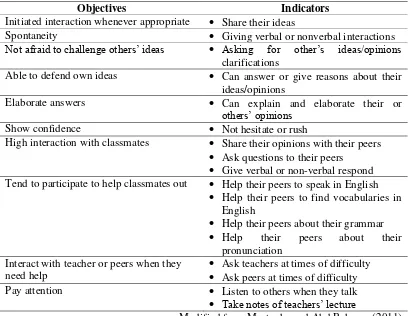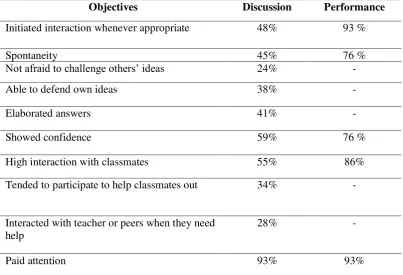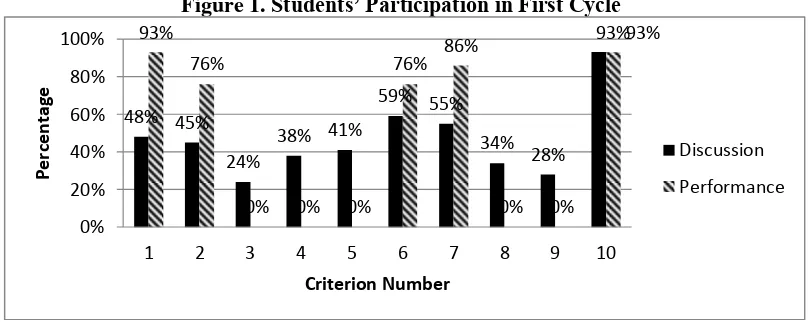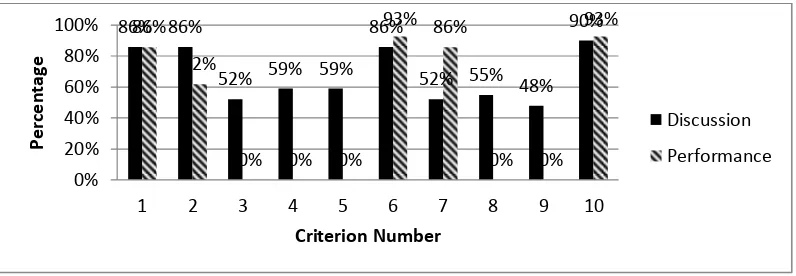A RESEARCH ARTICLE
By:
FIPPI APRILA
F1021131034
ENGLISH LANGUAGE EDUCATION STUDY PROGRAM
LANGUAGES AND ARTS EDUCATION DEPARTMENT
TEACHING TRAINING AND EDUCATION FACULTY
TANJUNGPURA UNIVERSITY
IMPROVING STUDENTS’ PARTICIPATION IN SPEAKING ENGLISH
USING TALK SHOW TECHNIQUE
Fippi Aprila, Eni Rosnija, Yanti Sri Rezeki
English Education Study Program FKIP Untan Pontianak Email: [email protected]
Abstract
This research was done to know how the use of Talk Show technique can improve students’ participation in speaking English. The form of this research was a classroom action research, in which the subject is the first grade students (X IPA 1) of SMA N 1 Sungai Raya in academic year 2016/2017. The data were collected using observation checklist, field notes, and recorders. The students’ participation were observed, calculated, analyzed, and classified. The result of this research showed that the students’ participation in each cycle has improved during their discussion and performance of their talk shows. The improvement can also be seen through the percentages: 47% (poor) for discussion and 85% (excellent) for performance on the first cycle and improved again to 67% (good) for discussion and 84% (excellent) for performance on the second cycle. In conclusion, the findings from the observation checklist and field notes confirmed that the use of Talk Show technique can improve students’ participation.
Keywords: Participation, Speaking English, Talk Show Technique
Abstrak
Penelitian ini dilakukan untuk mengetahui bagaimana pengaplikasian teknik Talk Show dapat meningkatkan partisipasi siswa dalam berbicara Bahasa Inggris. Bentuk dari penelitian ini adalah penelitian tindakan kelas, yang mana subjeknya adalah siswa kelas satu (X IPA 1) di SMA N 1 Sungai Raya pada tahun ajaran 2016/2017. Data dikumpulkan menggunakan daftar observasi, catatan lapangan, dan alat rekam. Partisipasi siswa diobservasi, dihitung, dianalisis, dan diklasifikasikan. Hasil dari penelitian ini menunjukkan bahwa partisipasi siswa pada setiap siklus meningkat pada saat diskusi dan penampilan talk show mereka. Peningkatannya juga dapat dilihat melalui persentasenya: 47% (buruk) untuk diskusi dan 85% (luar biasa) pada penampilan di siklus pertama dan meningkat lagi menjadi 67% (bagus) untuk diskusi dan 84% (luar biasa) pada penampilan di siklus kedua. Kesimpulannya, hasil temuan dari daftar observasi dan catatan lapangan mengkonfirmasi bahwa penggunaan teknik Talk Show dapat meningkatkan partisipasi siswa.
Kata Kunci: Partisipasi, Berbicara dalam Bahasa Inggris, Teknik Talk Show
The tenth grade students, specifically at X IPA 1, of SMA N 1 Sungai Raya in academic year 2016/2017 did not participate actively in speaking English. The problems are that: (1) some students did not want to speak up even when they were pointed directly by the teacher, (2) they were afraid of making mistakes, (3) some students
their participation, which can be done by using certain techniques.
The technique that was used in this research to improve students‟ participation is Talk Show technique. In talk show technique, all students have to participate in the activity. Each student plays a role. Klippel (1985) divided the roles in talk show technique into three: hosts, guests, and audiences. All of the roles played by the students will open opportunities to speak within their groups. In addition, Nimehchisalem (2013) stated that this technique is advantageous for engaging students to participate. They will be able to practice their speaking skill in the discussion maximize students‟ potential to be more active, to enhance their participation by asking questions, offering ideas, giving suggestions, and even listening to their teacher and peers. Thus, every student can participate actively in the learning process using this technique.
A class is considered working well when the students participate in the entire process of learning. Murray and Lang (1997) stated “students who participate actively in the classroom will in fact learn the subject matter more effectively than students that are taught in the traditional lecture mode…”. Students‟ participation can be assessed by observation using rubrics. Czekanski and Wolf (2013, p. 6) stated “rubrics and other guidelines provide details of performance expectations in courses, and include a range of marks for levels of class participation”.
There are some objectives that can be used for assessing participation. Based on Mustapa and Abd Rahman‟s (2011) opinion, they are: 1) Initiate interaction whenever appropriate, 2) Spontaneity, 3) Not afraid to challenge
others‟ ideas, 4) Able to defend own ideas, 5) Elaborate answers, 6) Show confidence, 7) High interaction with classmates, 8) Tend to participate to help classmates out, 9) Interact with teacher or peers when they need help, and 10) Pay attention.
The students are considered able to initiate interaction when they take any opportunity to share their ideas for their talk show. They can be spontaneous in making their talk show by giving nonverbal interactions naturally. Mustapha and Abd Rahman (2011, p. 154) stated “they used their hands, head or facial expression to show agreement or disagreement with what was being discussed in class”. In addition, their questions or feedback can also be spontaneous (Mustapha & Abd Rahman, 2011). The students can participate actively by asking for others‟ clarification of their opinions or ideas politely to show that they are not afraid to challenge others‟ ideas. When the students convey their opinions, they can also elaborate their opinions to make them clear. Mustapha and Abd Rahman (2011, p. 151) stated “they can defend their ideas by explaining the logic behind their ideas and share with the class their thought processes”.
They can ask teachers or their peers at times of difficulty in making their talk show. The students also must pay attention to their classmates and teacher by listening or even taking notes. These are the indicators to show that students participate actively in the classroom.
RESEARCH METHODOLOGY
This research was done as a classroom action research. The researcher did this research within two cycles. Each cycle consists of four stages: plan, act, observe, and reflect. The subject of this research is the tenth grade students of SMA Negeri 1 Sungai Raya in academic year 2016/2017, specifically at Class X IPA 1. To be able to analyze the students‟ participation improvement, the
researcher wanted to get qualitative data about students‟ participation in speaking activities. In this research, the observation was done by using observation checklist, field notes, audio recorders and video recorders to help the researcher collect the data easily. The observation checklist was used to see the students‟ participation during the teaching-learning process using Talk Show technique. The field note was used to help the researcher have better insights and remember important details of what happened during the observation. The recordings were used for further reflection for the researcher in each cycle. The specification of the observation checklist used by the researcher is as follows:
Table 1. Specifications for Discussion
Objectives Indicators
Initiated interaction whenever appropriate Share their ideas
Spontaneity Giving verbal or nonverbal interactions Not afraid to challenge others‟ ideas Asking for other‟s ideas/opinions
clarifications
Able to defend own ideas Can answer or give reasons about their ideas/opinions
Elaborate answers Can explain and elaborate their or others‟ opinions
Show confidence Not hesitate or rush
High interaction with classmates Share their opinions with their peers Ask questions to their peers
Give verbal or non-verbal respond Tend to participate to help classmates out Help their peers to speak in English
Help their peers to find vocabularies in English
Help their peers about their grammar Help their peers about their
pronunciation Interact with teacher or peers when they
need help
Ask teachers at times of difficulty Ask peers at times of difficulty
Pay attention Listen to others when they talk
Take notes of teachers‟ lecture
Table 2. Specifications for Performance
Objectives Indicators
Initiated interaction whenever appropriate Share their ideas
Spontaneity Giving verbal or nonverbal interactions
Show confidence Not hesitate or rush
High interaction with classmates Talk to their group based on their roles
Pay attention Listen to others when they talk
Modified from Mustapha and Abd Rahman (2011)
The data gathered from recordings and field notes were used to help the researcher analyze and score the students in the observation checklist. The collected data from the observation checklist in this research would be analyzed by counting the percentage through proportion technique formula as follows:
... (1)
Note:
K = The percentage of active participation in each activity
A = The number of students who actively participates
N = The number of whole students
The result then will be categorized as follows:
Table 3. Percentage Qualification
Students‟ score Category Qualification
80 – 100 A Excellent
60 – 79 B Good
50 – 59 C Average
0 – 49 D Poor
(Modified from Heaton (1990))
This research involved the subject teacher as the observer in the classroom activities, and the researcher as the teacher in the classroom activities.
RESULT AND DISCUSSIONS Result
The data gathered are divided into two categories: discussion stage and performance stage, where both of the categories are included in each cycle. The material for the first cycle is simple past tense, while for the second cycle is adverb of time. Based on the observation, it is proved that students‟ participation in speaking English improved by using talk show technique. The improvement is described as follows:
In the first cycle, most of the students were still passive on the discussion stage. On the other hand, on the performance stage, the students mostly participated actively. Half of the students in the class interacted with each other to make their talk shows‟ conversations by asking and giving opinions. For example, in discussion of Group 2, the students asked and gave their opinions about their talk show‟s topic:
An: “What is the topic today?” Ar: “I think eer..”
N: “About trending topic!”
each other‟ opinions. The students also could elaborate their answers. Furthermore, the students showed high interaction with classmates by giving and asking opinions. They also asked the teacher when they felt confused about certain things, like each role duty in their talk show and how to make the conversations because some of the students were still confused on how a talk show should be. The students also helped their team mates by searching for
examples in the internet and helped them with vocabularies.
When the students performed, most of the students still brought some notes to help them. This also made some students‟ pronunciation was terrible. However, there were also some students who did not bring any notes and could perform well and spontaneously.
The percentage of students‟ participation on the first cycle based on the observation checklist is as follows:
Table 4. First Cycle Percentage
Objectives Discussion Performance
Initiated interaction whenever appropriate 48% 93 %
Spontaneity 45% 76 %
Not afraid to challenge others‟ ideas 24% -
Able to defend own ideas 38% -
Elaborated answers 41% -
Showed confidence 59% 76 %
High interaction with classmates 55% 86%
Tended to participate to help classmates out 34% -
Interacted with teacher or peers when they need help
28% -
Paid attention 93% 93%
Overall, the students‟ participation in discussion stage of first cycle was 47%, which is categorized as poor. By contrast, the students‟ participation in performance stage of first cycle was 85%, which is categorized as excellent.
In the second cycle, most of the students participated more actively compared with in the first cycle on the discussion stage. Most of the students interacted more actively to make their talk shows‟ conversations by asking and giving opinions. The students also could
elaborate their opinions. For example, in discussion of Group 2, a student elaborated her opinion by saying:
E: “I mean you are an actress, it‟s about movies that you like not movies you are in.”
and even spelled some vocabularies for their friends. The students also challenged and defended their opinions bravely. They also interacted with the teacher to ask for help in vocabularies, grammar and ideas.
When the students performed, there were still some students who brought notes. However, they didn‟t use them to merely read, but to be glanced at. Despites so, some students could also perform without any notes. The
students‟ also showed more confidence compared to the first cycle by speaking louder and looked at their classmates when they talked. They were also being spontaneous by chanting some students‟ names, clapping when the guests came in, and other nonverbal gestures like hugging the guests, waving hands, and laughing. The percentage of students‟ participation on the second cycle based on the observation checklist is as follows:
Table 5. Second Cycle Percentage
Objectives Discussion Performance
Initiated interaction whenever appropriate 86% 86%
Spontaneity 86% 62%
Not afraid to challenge others‟ ideas 52% -
Able to defend own ideas 59% -
Elaborated answers 59% -
Showed confidence 86% 93%
High interaction with classmates 52% 86%
Tended to participate to help classmates out 55% -
Interacted with teacher or peers when they need help
48% -
Paid attention 90% 93%
Overall, the students‟ participation in discussion stage was 67%, which is categorized as good. By contrast, the students‟ participation in performance stage was 84%, which is categorized as excellent. It means that the students participate actively both in their performance and discussion.
Discussions
In this study, the researcher found that Talk Show improved students‟
they didn‟t know, looked up for examples of Talk Show as their references, looked up e-dictionary (Google Translate) to help them making their talk shows dialogues. This is aligned with Nimehchisalem (2013) statement planning of conducting their talk shows. Although sometimes the students still talk in their first language, the students frequently tried to speak in English for short replies, like „yes‟ and „no‟.
On the performance stage, the students were enthusiastic to show their talk shows and to watch their friends‟ talk shows. Most of them were being spontaneous by giving small comments and clapped hands in each show. This is also aligned with Nimehchisalem‟ (2013) statement that every student also may add spontaneous gestures, small jokes, and words in their performances.
From the field notes taken by the observer, most students show enthusiasm in learning English by using Talk Show technique. This is in line with Klippel‟s (1985) theory that Talk show technique is guided by the
intention to achieve effective language learning situations.
According to the observation checklist of first cycle, the students‟ participation in discussion stage is categorized as poor. Meanwhile, the students‟ participation in performance stage is categorized as excellent. In contrast, in the second cycle, the students‟ participation in discussion stage is categorized as good and the students‟ participation in performance stage is categorized as excellent. On the first cycle, 47% of the students participate actively in the discussion stage and 85% of the students participate actively in the performance stage. In which, this result shows that only some students who participate actively. However, in the second cycle, the result shows students participation has improved again. It is shown that 67% of the students participate actively in the discussion stage and 84% of the students participate actively in the performance stage.
Each cycle improvement can be seen in the following charts:
Figure 1. Students’ Participation in First Cycle
Figure 2. Students’ Participation in Second Cycle
The overall results indicated that the students‟ participation has significantly improved in speaking using Talk Show technique. The findings confirmed the previous study (Nimehchisalem, 2013) that Talk Show is advantageous for engaging students to participate in speaking class. In conclusion, the researcher has answered the research problems by describing the teaching and learning process using Talk Show technique.
CONCLUSIONS AND SUGGESTIONS Conclusions
The researcher concludes that: 1) Talk Show technique improves students‟ participation in speaking. It can be seen from the percentage 47 % and 85% on the first cycle and improved to 67% and 84% on the second cycle, 2) Talk Show technique improves students‟ participation in students‟ discussion by writing their conversations for their talk shows, 3) Talk Show technique improves students‟ participation in students‟ talk show performances by having the students to talk in English to each other like in a talk show, and 4) Students participated actively in learning English using Talk Show technique and showed enthusiasm in performing their talk shows.
In conclusion, the students‟ participation has improved as shown in the first and second cycle. Therefore, the action hypothesis that the students‟
participation will improve during the teaching and learning process using talk show technique is proved correct.
Suggestions
Based on this study, the researcher would like to propose some suggestions to improve teaching and learning process, especially in students‟ participation. They are: 1) tell the students beforehand that their participation in the class activities will be graded, 2) write down the procedures of Talk Show technique and the working in groups to give them chances to ask the teacher about what they don‟t know.
BIBLIOGRAPHY
Bean, J. C., & Peterson, D. (1998). Grading classroom participation. New Directions for Teaching and Learning, 33-40.
Brown, H. D. (2000). Teaching by
principles: An interactive
Burns, A. (2010). Doing action research in language English teaching: A guide for practitioners. New York: Routledge. States of America: Routledge. Creswell, J. W. (2012). Education
research (4th ed.). Boston: Pearson Education Inc.
Czekanski, K. E., & Wolf, Z. R. (2013). Encouraging and evaluating class participation. Journal of University Teaching & Learning Practice, X(1), 7-21.
Ferrance, E. (2000). Action reserach. New York: LAB Brown University.
Guillemin, M. (2014, October). Assessing class participation: What, why and how? Retrieved from Teaching and Learning Quality Assurance Committee (TALQAC):
http://arts.unimelb.edu.au/__dat a/assets/pdf_file/0006/1722399/ assessing-class-participation.pdf Harmer, J. (2001). The practice of
English language teaching (3rd ed.). New York: Longman Inc. Harmer, J. (2007). The practice of
English language teaching (4th ed.). Harlow: Pearson Education.
Harmin, M., & Toth, M. (2016). Inspiring active learning: A complete handbook for today's teachers. Alexandria, Virginia: Association for Supervision and Curriculum Development. Heaton, J. B. (1990). Writing English
language tests. New York: Longman Inc.
Howard, J. (2002). Do college students participate more in discussion in traditional delivery courses or in
interactive telecourses?: A preliminary comparison. The Journal of Higher Education, 764-780.
Hughes, A. (1996). Testing for language
teachers. Cambridge, Great
Britain: Press Syndicate of the University of Cambridge. Jeanette. (2001). Teaching English as a
second or foreign language (3rd ed.). (M. Celce-Murcia, Ed.) Boston, U.S.A.: Thomson Learning Inc.
Klippel, F. (1985). Keep talking: Communiative fluency activities for language teaching. Avon: Press Syndicate of the University of Cambridge. Liu, J. (2001). Asian students’
classroom communication
patterns in U.S. universities: An emic perspective. Wesport CT, USA: Greenwood Publishing Group, Inc.
Mappiasse, S. S., & Johari, A. B. (2014). Evaluation of English as a foreign language and its curriculum in indonesia: a review. English Language Teaching Journal, VII, 113-122. Maznevski, M. L. (1996, January). Grading Class Participation. Charlottesville: University of Virginia.
Mukminin, A., Masbirorotni, Noprival, Sutarno, Arif, N., & Maimunah. (2015). EFL speaking anxiety among senior high school students and policy recommendation. Journal of Education and Learning, IX(3), 217-225.
Murray, H. G., & Lang, M. (1997). Teaching and learning in higher education. Western Ontario: Newsletter of the Society for Teaching and Learning in Higher Education.
study of international students‟ classroom participation at one of the colleges in Malaysia. International Journal for the Advancement of Science & Arts, I(2), 91-99.
Mustapha, S. M., & Abd Rahman, N. S. (2011). Classroom participation patterns: A case study of malaysian undergraduate students. International Journal for Educational Studies, III(2), 145-158.
Nation, I. S., & Newton, J. (2009). Teaching ESL / EFL listening
and speaking. New York:
Routledge.
Nimehchisalem, V. (2013, September). The talk show method in ESL
classroom. Voices in Asia Journal 2013, 1(1), 58-71. Richards, J. C. (2008). Teaching
listening and speaking from theory to practice. New York, United States of America: Cambridge University Press. Richards, J. C., & Rodgers, T. S. (1999).
Approaches and methods in langauge teaching. New York: Cambridge University Press. Rocca, K. A. (2010, April). Student
participation in the college classroom an extended multidisciplinary literature review. Communication Education, 185-213.




